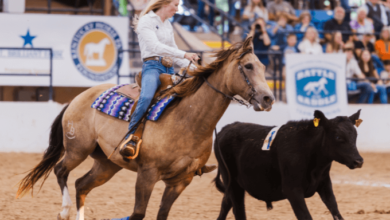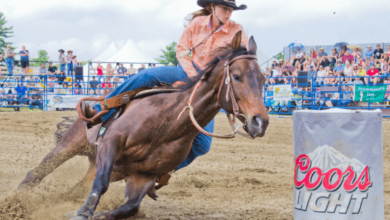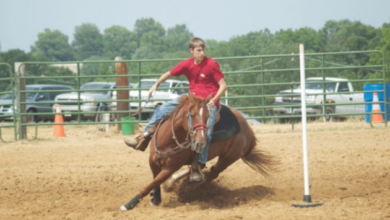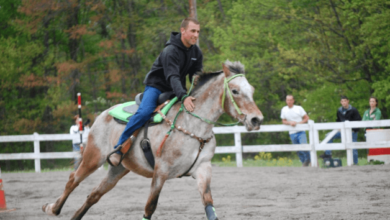What are the different gaits in western pleasure?

Western pleasure is one of the most popular disciplines in the world of Western riding, known for its smooth, relaxed style and focus on the horse’s ability to move in a calm and collected manner. Riders in Western pleasure competitions are judged on their horse’s ability to perform a series of gaits with a smooth, controlled, and relaxed demeanor. While the emphasis in this discipline is on precision, fluidity, and ease, the different gaits are the foundation that defines the competition.
In Western pleasure, the horse must demonstrate several distinct gaits, each with its own set of expectations in terms of speed, rhythm, and overall demeanor. Let’s take a closer look at the main gaits that are judged in Western pleasure and the characteristics that set each one apart.
Walk
The walk is the slowest and most basic gait, but it plays a crucial role in Western pleasure competitions. The walk is a four-beat gait where each of the horse’s feet moves independently, creating a steady, rhythmic pattern. In Western pleasure, the walk should be calm, collected, and smooth, with no signs of tension or hurriedness. Judges look for a horse that moves forward with purpose but maintains a relaxed and easy-going demeanor.
A proper walk in Western pleasure has a distinct set of characteristics:
- Four-beat rhythm: Each foot should hit the ground independently in a clear, consistent pattern. This gait begins with the left hind leg, followed by the left front, right hind, and right front legs in sequence.
- Relaxation and rhythm: The horse must walk with a relaxed head and neck, showing minimal movement in the rider’s hands, meaning the horse is well-trained and cooperative.
- Steady forward movement: Although the walk is slow, it should still have forward momentum. Judges want to see a horse that covers ground with an active, purposeful step, without laziness or hesitation.
In Western pleasure, the walk often sets the tone for the entire ride, establishing the horse’s ability to stay calm, steady, and attentive to the rider’s cues.
Jog
The jog is a signature gait in Western pleasure and can be compared to the trot in English riding. However, unlike the trot, the jog is slower, smoother, and more relaxed. This is a two-beat gait in which the horse’s legs move in diagonal pairs (right front and left hind, followed by left front and right hind). The jog must be performed with minimal bounce or jarring movements, and the horse should appear to be moving effortlessly.
The jog in Western pleasure should exhibit the following qualities:
- Two-beat gait: A well-executed jog is a diagonal movement, where the horse lifts its diagonal legs simultaneously and places them down with a smooth, even rhythm.
- Slow and collected: Judges expect the jog to be slow but not sluggish, with a collected frame that shows control and responsiveness. The horse should carry its head level with or slightly above the withers, maintaining a natural, relaxed posture.
- Smoothness and cadence: One of the hallmarks of the jog is its smoothness. There should be little to no bouncing in the saddle, and the horse should maintain a steady cadence, appearing as though it is gliding across the arena.
- Relaxation and responsiveness: The horse should respond to the rider’s cues with subtlety, maintaining a calm demeanor without appearing distracted or resistant.
Because the jog is one of the most frequently used gaits in Western pleasure, horses are expected to maintain this gait for extended periods without losing rhythm or smoothness. A well-executed jog is a sign of a well-trained and balanced horse.
Lope
The lope is another critical gait in Western pleasure and is roughly equivalent to the canter in English riding. The lope is a three-beat gait that should be performed with a slow, relaxed tempo while maintaining smoothness and precision. Like the jog, the lope is expected to be collected and controlled, with the horse displaying a calm demeanor while covering ground in a fluid manner.
Key characteristics of the lope in Western pleasure include:
- Three-beat rhythm: The lope follows a distinct three-beat pattern. In a left lead lope, the right hind leg strikes first, followed by the simultaneous landing of the left hind and right front legs, and then the left front leg. The opposite occurs for the right lead lope.
- Cadence and smoothness: The lope should be slow and controlled but not appear forced or artificial. Judges look for a lope that is smooth, with minimal bounce in the rider’s seat and a steady, rhythmic cadence that doesn’t break or falter.
- Collection and frame: A proper Western pleasure lope involves a collected frame, meaning the horse’s head and neck should be held naturally without excessive pulling or tension on the reins. The horse should carry itself in a balanced and relaxed manner, showing softness in its movements.
- Relaxed and willing demeanor: The lope should demonstrate the horse’s willingness to cooperate with the rider’s cues, remaining calm and relaxed throughout the gait. The horse should show no signs of resistance, such as head tossing or rushing, and should transition smoothly into and out of the lope.
The lope is often one of the most challenging gaits for both riders and horses, as maintaining the correct tempo, lead, and frame requires balance, strength, and precision.
Extended Jog
In addition to the standard jog, Western pleasure competitions often require an extended jog, which is essentially a faster version of the jog while maintaining the same two-beat diagonal rhythm. The extended jog allows the horse to show more ground coverage and forward motion while still demonstrating control and smoothness.
The extended jog is characterized by:
- Increased speed: The horse should move faster than at the regular jog, but without sacrificing smoothness or rhythm. The extension should be clear and purposeful, showing the horse’s ability to lengthen its stride without rushing.
- Maintaining the two-beat cadence: Even though the extended jog covers more ground, the horse must maintain the same two-beat diagonal rhythm as in the regular jog, with no hint of bouncing or jarring.
- Balance and collection: While the horse moves more quickly, it must remain balanced and collected, showing that it can perform the gait with poise and control. The horse’s head and neck should still be in a relaxed, natural position, without excessive tension in the reins or frame.
- Smooth transitions: A key part of the extended jog is the ability to transition smoothly in and out of it. The horse should move fluidly from the regular jog into the extended jog and back without breaking rhythm or appearing unsteady.
The extended jog is an excellent opportunity for horses to showcase their athleticism and responsiveness to their rider’s cues, while still adhering to the relaxed and controlled style of Western pleasure.
Hand Gallop (Less Common)
Though not always included in Western pleasure competitions, some events may ask for a hand gallop. The hand gallop is a faster gait than the lope, approaching the speed of a full gallop but with a level of control and collection that differentiates it from an all-out sprint.
The characteristics of the hand gallop include:
- Four-beat rhythm: Unlike the lope, the hand gallop typically becomes a four-beat gait, similar to a controlled gallop. This allows the horse to cover more ground with greater speed.
- Forward movement with control: While the hand gallop is faster, it must still show control and fluidity. The horse should move forward with power, but without becoming out of control or losing its relaxed demeanor.
- Balance and collection: Even at increased speed, the horse must maintain its balance and respond smoothly to the rider’s cues. Judges will be looking for a horse that can handle the increased pace without becoming tense or erratic.
The hand gallop, when asked for, offers riders and horses a chance to demonstrate athletic ability and speed while still staying within the bounds of control that Western pleasure demands.
Transitions Between Gaits
One of the most critical aspects of Western pleasure is the horse’s ability to transition smoothly between gaits. Transitions between the walk, jog, lope, and extended jog must be seamless, without jarring movements or disruptions in rhythm. Judges look for horses that respond promptly to the rider’s cues, moving from one gait to the next with ease and fluidity.
Successful transitions demonstrate several qualities:
- Responsiveness: The horse should respond immediately to the rider’s cues without hesitation or resistance. The transition should appear effortless, with minimal disruption to the horse’s rhythm and balance.
- Smoothness: Whether transitioning from a walk to a jog or a jog to a lope, the horse should make the change in a smooth, fluid motion, without bouncing or throwing the rider off balance.
- Control and relaxation: Throughout the transition, the horse should remain calm and controlled, maintaining its relaxed posture and collected frame.
Good transitions are often the mark of a well-trained horse and a skilled rider, as they show the level of communication and harmony between the two.
Conclusion
The gaits in Western pleasure, from the walk and jog to the lope and extended jog, are the foundation of the sport. Each gait requires a unique combination of smoothness, control, and relaxation, with an emphasis on precision and responsiveness. Whether at the slow, steady walk or the faster extended jog, horses in Western pleasure must move with elegance, maintaining a calm demeanor and a collected frame throughout.
For riders looking to excel in Western pleasure, mastering these gaits and the transitions between them is essential. Through practice, patience, and an understanding of the subtleties of each gait, riders can develop the skills needed to succeed in this graceful and rewarding discipline.



